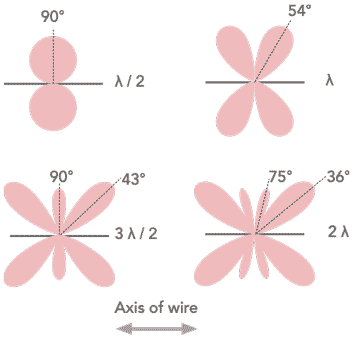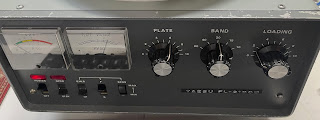The ins and outs of random wire HF antennas
If you've checked out my QRZ page, you've read about my home ham shack, which includes an ICOM IC-7300 that is connected to a so-called "random wire" antenna, which is an end-fed wire antenna. I've used this antenna quite successfully in various configurations since 2020, allowing me to make over 2,000 confirmed QSOs across 117 countries to date, using digital, SSB, and CW, the bulk of which running 100 watts or less. I have completed QSOs on literally every ham band from 160 meters to 6 meters using this antenna (and a tuner). So the antenna quite obviously performs quite well!
I'll begin by describing the characteristics of a random wire antenna. Some people call it a "compromise" antenna, but in my mind, just about every antenna is a compromise of one form or another. As Dave Casler (KE0OG) is fond of saying, "the best antenna is the one you have!" The name comes from the fact that the length of the antenna, in theory, could be any random length, with one major caveat: it can't be resonant on any of the bands you intend to work. Yes, you read that right: it's NON resonant on the bands you want to work! I was skeptical at first as well, having read all about the virtues of resonant antennas. Let's dive into a little bit of theory.
A random wire antenna, cut to the appropriate length as described above, presents around a 450-ohm impedance to the radio, which varies depending on frequency. As one might suspect, this is not usable as-is, so a 9:1 matching transformer (Unun) is used to bring the impedance down to approximately 50-ohms, and combined with a matching network, aka antenna "tuner", you wind up with a very workable SWR and an antenna that resonates on the frequency being used. It's like magic.
In terms of deploying the antenna, like most wire antennas, random wires work best when deployed as far above ground as possible, particularly in the lower bands, eg 160 meters. They can be configured in any number of ways, such as an inverted "V", inverted "L", etc. I have mine configured in an inverted L of sorts, where it runs straight up to the top of a 50 foot Spruce tree, then across my property to another tall Ash tree, and then down to the rear of my property where it's attached to my fence (out of range of humans and pets). I also have a 10 meter (ish) counterpoise which runs along the top of my 6' fence. Some people use ground instead of a counterpoise, but my experiments have shown that a counterpoise performed slightly better.
As far as radiation pattern, random wires radiate similar to a dipole, which is to say that the pattern runs perpendicular to the wire in a bit of a "flower" pattern. The actual pattern varies considerably, mostly based on distance of the antenna from the ground and the wavelength in use. As one might suspect, it's pretty critical to plan out the anticipated radiation pattern based on the regions that you'd prefer to work. My antenna runs roughly Northeast to Southwest, giving me a radiation pattern that runs Northwest on one side and Southeast on the other. So from my QTH in the Denver area, I have no problems reaching California and the Northwest US, as well as Japan, Korea, and China, as well as the Southeast US. But, interestingly, I also regularly have QSOs with the Northeast US, as well as all over Europe and South America. I'm not sure if some of that is "long path" propagation, but I'm still amazed at the geographical coverage this antenna provides. About the only clear nulls that I've found are directly to the South (like Texas) and North (Alberta Canada).
(Source: Electronic Notes--link at the bottom of the article)
Next, I'll dive into specifics around my particular antenna. I began by purchasing the Palomar Engineers random wire antenna "kit' sold by Ham Radio Outlet, which cost around $99 at the time (it's now $129). This included 71 feet of wire, a "bullet" 9:1 Unun, counterpoise wire, and a common mode choke (basically a large toroidal 'doughnut') that keeps common mode currents from getting into your shack.
When I first deployed the antenna, I had no way to get it up into my trees, so I literally just ran it across the top of my roofline and down to my fence. As one might suspect, between some coupling with my roof (lots of metal nails and such) and the lack of elevation, it wasn't great--but it *did* work! My very first HF QSO was with a guy in California on 20 meter SSB, who gave me a 5/5 signal report.
Later on, a buddy and I split the cost of an "AirBoss" antenna launcher, which is a genius piece of kit that allows you to shoot a lead fishing weight connected to a fishing reel and line well over 60 feet high in the air. I replaced the original 71 foot wire with 203 feet of 13-gauge wire and was able to launch it over the top of my two trees, giving me about a 50-foot elevation and a much longer run. The wire is black and is nearly invisible--you really need to look for it in order to spot it. And as I mentioned above, I also ran a 10-meter counterpoise off of the Unun. And as you might suspect, all of a sudden, my antenna performed *much* better!
The only piece of equipment that you absolutely need with a random wire antenna is an antenna "tuner". I've found that the tuner built in to my ICOM IC-7300 works very well, with the exception of 160 meters. I'm now using an LDG AT-600 Pro II tuner, which works even better and allows me to work literally every band from 160 to 6 meters.
Speaking of 6 meters, aka "the magic band," I have found that my random wire antenna does not work terribly well. I think this may be a polarization issue. Since the antenna is horizontally polarized, and most 6-meter QSOs occur at shorter distances (other than at solar maximums), my feeling is that a lot of people that work 6 meters probably have vertically polarized antennas. So my plan is to deploy a separate vertically polarized 6-meter antenna and see if that improves the situation. More on that later!
I hope this article has helped to shed some light on random wire antennas, and maybe helps some of you who may be on the fence about deploying one. As always, if I can answer any questions about my experiences, feel free to email me at k0ehr {at} arrl.net.
73s!
Additional resources:
Electronic Notes article on random wire antennas (includes a nice writeup on radiation patterns)
Random wire antenna lengths (udel.edu)
Palomar Engineers (maker of my random wire antenna 9:1 Unun, aka "The Bullet")





Comments
Post a Comment